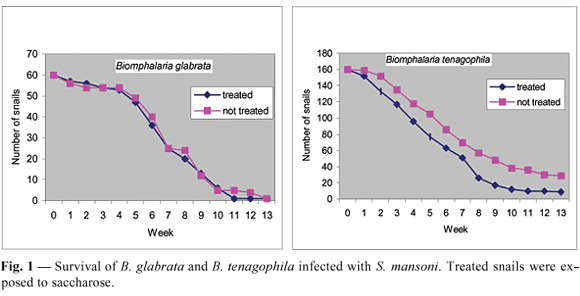The development of cercariae from Schistosoma mansoni strains BH and SJ in Biomphalaria glabrata and Biomphalaria tenagophila treated with saccharose was studied. The molluscs were maintained in dechlorinated tap water containing 0.01% saccharose. After one week of treatment with saccharose, B. glabrata and B. tenagophila were exposed to ten S. mansoni miracidia, from BH and SJ strains respectively. Control snails of both species were maintained in dechlorinated tap water without saccharose and exposed to the same number of miracidia. There was no significant difference between the infection rates of snails treated or not with saccharose. However, the two groups of B. glabrata had significantly greater infection rates than the corresponding B. tenagophila groups. Molluscs treated with saccharose had a lower survival rate, with the greatest mortality occurring immediately before and at the beginning of cercariae release. Treatment with saccharose did not result in the release of more cercariae, but larvae from molluscs so treated showed a greater capacity to penetrate mouse skin, which was attributed to the greater energy supply during larval development in the mollusc.
Planorbidae; Biomphalaria glabrata; Biomphalaria tenagophila; Schistosoma mansoni; saccharose




